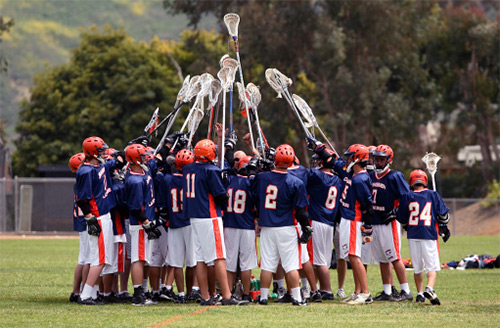New Research to Focus on Youth Lacrosse Injuries
March 19, 2014
Mason professors will soon begin US Lacrosse-funded research that uses sensors to track how and why head and other injuries occur.
The article below was written by Preston Williams and originally appeared on Mason News.
* * *
This week, George Mason University will begin important research that could lead to rule or equipment changes that would better protect young athletes from injury, including head injuries.
Shane Caswell, associate professor of athletic training in George Mason’s College of Education and Human Development, will lead the US Lacrosse-funded research that will track male and female varsity lacrosse players at Patriot High School in Nokesville, Va. The athletes will be outfitted with sensors called accelerometers that could reveal new data about how and why lacrosse injuries occur. US Lacrosse is the national governing body for the sport.

Research at Patiot High School may lead to better protection for high school lacrosse players.
“We want to capture some really valuable information that no one has captured before about high school lacrosse,” says Caswell, who runs the Sports Medicine Assessment Research and Testing (SMART) Laboratory on Mason’s Science and Technology Campus, which is about six miles from Patriot High.
The SMART Lab team will add small devices called GForce Trackers to the helmets of the male players. Female players will wear a different type of sensor, called an X2 patch, behind their ears. Both instruments are about the size of a front tooth.
The SMART Lab team also will record every practice and home game to attain video information to supplement the sensor and injury data collected during the latest of the organization’s many community outreach projects.
“If we can use video data combined with sensor data to understand just how frequently people are being impacted through the course of the season by the stick, ball or body, then we can develop targeted, informed strategies to intervene,” Caswell says. “It could be rule changes or equipment changes. It helps us to better understand in what game-play situations collisions occur, and how frequently someone is struck with a stick to the head.”

The SMART Lab conducts evidence-based research in the areas of injury prevention in youth sports and other areas. Photo by ckindel, Creative Commons license.
Caswell will be joined in the study by Nelson Cortes, an associate professor in the School of Recreation, Health, and Tourism. A number of Mason students will assist in the project, including undergraduates from athletic training, kinesiology and biology, and graduate students from exercise, fitness, and health promotion.
Cara Cheetham, a graduate assistant and certified athletic trainer at Patriot High, with funding from the Prince William Health Services Foundation, will handle most of the medical care and injury documentation associated with the study. Fellow graduate student Rachel Kazman, also a certified athletic trainer, will help with the sensor application and the video data collection.
The SMART Lab this spring also is conducting a concurrent study separate from the US Lacrosse project. Together with Emanuel “Chip” Petricoin, co-director of the Center for Applied Proteomics and Molecular Medicine in the College of Science, Caswell will collect saliva samples from the Patriot lacrosse players before the season, every week during the season and then after the season to try to correlate salivary biomarkers with the impactful blows to the head absorbed during that period. (See story here).
The goal, Caswell says, is to determine whether hits to the head result in changes to the physiology of the saliva, information that could one day lead to saliva being used in a test to help diagnose concussions and determine when it is safe to return to play. The SMART Lab conducted a similar study last fall.
About CEHD
George Mason University's College of Education and Human Development (CEHD) includes two schools: the Graduate School of Education, one of the largest teacher preparation and education schools in Virginia, and the School of Recreation, Health, and Tourism. CEHD offers a comprehensive range of degrees, certificates, courses, and licensure programs on campus, online, and on site. The college is distinguished by faculty who encourage new ways of thinking and pioneering research supported by more than $75 million in funding over the past five years.
For additional information:
- CEHD Communications: cehdnews@gmu.edu
- College of Education and Human Development: cehd.gmu.edu
- School of Recreation, Health, and Tourism: rht.gmu.edu
Follow CEHD on Facebook at www.facebook.com/MasonCEHD or Twitter at @MasonCEHD.
